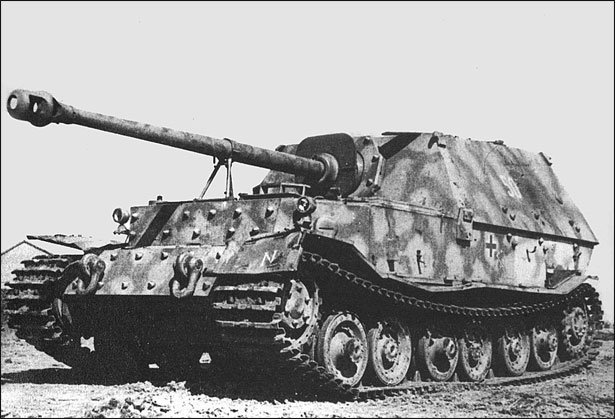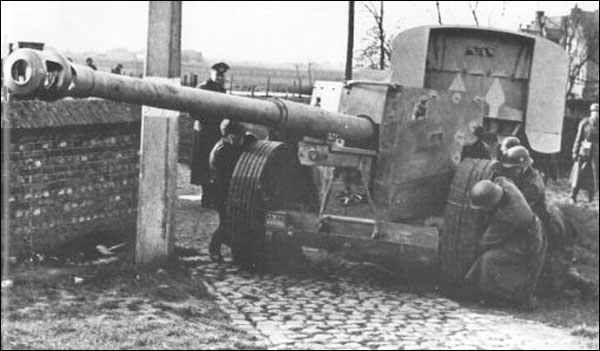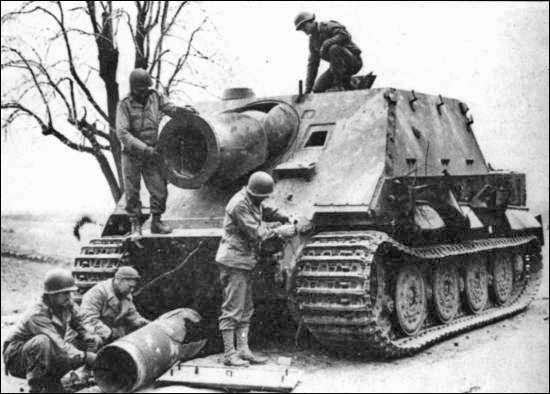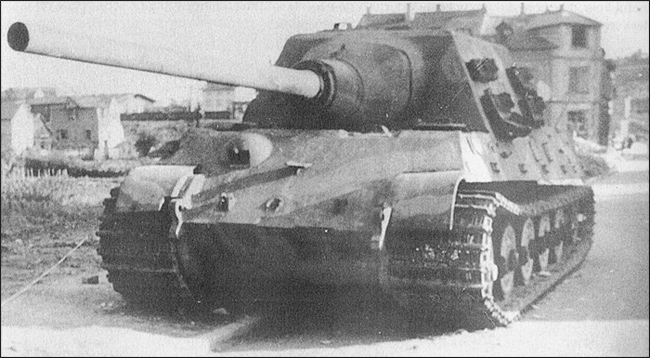Panzerjäger Tiger (P) "Ferdinand"/"Elefant"(SdKfz.184)
Although the Porsche prototype had lost the Tiger production competition to the Henschel VK 4501(H) prototype, ninety Porsche vehicles were ordered from Nibelungenwerke, a Steyr-Daimler extension factory in Austria, as a hedge against possible delays in production of the Henschel-built Tiger. The VK 4501(P) prototype had been developed from Porsche's earlier VK3001(P) project and used the same basic powertrain which consisted of two air-cooled gasoline engines driving electrical generators. These generators drove two electric motors which provided power to the tracks. In the event, the air-cooled engines proved to be a source of continual problems, while the electric motor drive system used an enormous amount of copper (which was a critical war material). These factors, as well as the superior handling and more familiar mechanical layout of the Henschel prototype, had resulted in Henschel receiving the Tiger production contract. Because of the problems in the Porsche powertrain design, the German Army did not want to put the vehicle into service. The prototypes were relegated to the training role; however, some use had to be found for the ninety chassis in storage in Nibelungen. It was determined that these chassis were suitable for conversion into the tank destroyers; mounting a long-range, high powered anti-tank gun. During 1942, eighty-five of the Porsche chassis were scheduled to be moved from Nibelungen to Alkett for conversion to the tank destroyer role. Dr. Porsche personally supervised the design work and the resulting vehicle was nicknamed Ferdinand (Porsche's first name) in his honor. The vehicle's official designation was Panzerjäger Tiger (P) "Ferdinand" (SdKfz.184) , although it was better known as the Jagdpanzer Ferdinand . The troublesome air-cooled engines of the VK 4501(P) were discarded and replaced with 300 hp Maybach HL120 water-cooled engines, while the electric drive system was retained. The engines were moved from the rear of the hull to the hull center so that the superstructure for the anti-tank gun could be set at the rear of the vehicle along with the track drive sprockets. The frontal armor on the hull was increased to 200 mm with the addition of bolted-on armor plates, and the new superstructure had 200 mm of frontal armor. Side armor was 80 mm except for the lower hull which had 60 mm armor. The rear armor was 80 mm thick. The main armament consisted of an 88 mm PaK 43/2 L/71 cannon, which was a longer and more powerful version of the main gun used on the Tiger I Ausf E.
Originally there was no secondary machine gun armament installed for protection from enemy infantry. The driver and radio operator sat at the front of the hull and the commander, gunner, and two loaders were located in the new superstructure. A large round escape hatch was fitted in the rear plate, with a small shell disposal hatch mounted inside the large hatch. Several vision slits and pistol ports were provided, but vision from inside the vehicle remained very poor. Additional hatches were installed in the roof, along with a ventilator and fan.
The Ferdinands were issued to s.Pz.Jäg.Abt.653 and s.Pz.Jäg.654 in the spring of 1943. They were committed to action during the great Kursk offensive near Orel in Russia. In combat they proved to be effective tank destroyers when engaging targets at long distances; however, their lack of secondary armament quickly became an urgent problem. Russian infantrymen were able to put several of the vehicles out of action by close-in infantry attacks and, at one point, Ferdinand crews were firing MG 42 machine guns down the barrels of the main gun while the gunners searched out groups of Russian infantry with the main gun sights. The surviving vehicles were sent back to Germany for repair and modifications. Several modifications were made: a cupola derived from the StuG III Ausf G self-propelled gun was installed on the superstructure roof, the tool storage was revised, and a bow mounted MG 34 machine gun was added to provide the vehicle with a degree of self-defense against infantry attack. A total of forty-eight Ferdinands underwent the modification programed, and were re-designated as Panzerjäger Tiger (P) "Elefant" - the change of the name was Hitler's suggestion, implemented by an order, on February, 1944. These vehicles were re-issued to s.Pz.Jäg,Abt.653 , for use in Italy during early 1944. Once again they proved to be successful as long range anti-tank guns; however, in the hilly terrain of Italy they were even more ungainly than they had been in Russia. The suspension proved to be highly vulnerable to mines, and a number of vehicles were lost due to mechanical breakdowns. A number of these broken down vehicles were towed to critical strong points and dug in for use as static defense positions. As such, they proved to be very effective in stalling Allied armor and infantry advances. In the event, the lack of reliability and good maneuverability hampered the Germans in making the best of the excellent armament of the Ferdinand/Elefant. 38 cm RW61 auf Sturmmörser Tiger.
The only major variant of the Tiger I Ausf E to reach production was the Sturmtiger, built on a late Tiger I chassis with steel-rimmed roadweels. With 150mm of front armor, the Sturmtiger was virtually impossible to penetrate with any Allied tank ammunition. The vehicle was intended to destroy fortified positions and buildings with its huge weapon. From late 1943, a total of 18 Tigers were converted to carriers for 38cm assault mortars, and designated 38 cm RW61 auf Sturmmörser Tiger , though more usually known as the Sturmtiger (assault Tiger). These vehicles had their turrets removed and a built-up fixed superstructure substituted. Derived from the barbettes fitted to self-propelled anti-tank guns, the structure had front and side walls angled at 30 degrees to the vertical. Their main armament was adjustable in elevation through an 85 degrees range, from horizontal to almost vertical, and through 20 degrees in traverse, both adjustments being made manually, via a worm-and-wheel /rack and pinion drive, and was a radically different design from that of any similar projector seen before. It used a cunningly conceived obturator to deflect the propellant gases through the space left between gun tube and liner, expelling them through a perforated ring at the muzzle and thus eliminating much of the recoil. The 38cm assault mortar fired 330kg (725lb) HE projectiles, fitted with stabilizing splines, out to a range of 6000m. The projectiles were too heavy for the crew to lift, and a small crane was used instead. Fully loaded, the Sturmtiger carried 13 rounds, one in the gun tube and 12 more in the side panniers. The mortar tube could only be loaded at zero elevation and zero azimuth, so the rate of fire was rather slow. The whole operation required four men, including the gunner, while the entire crew consisted of seven. A single 7.92mm MG34 machine gun was fitted in a ball mount in the front plate. Panzerjäger Tiger Ausf.B "Jagdtiger"
German Army policy during mid-1943 was to develop a self-propelled gun mount based on each new tank chassis design. This allowed the Germans the capability of mounting a much larger weapon on the chassis than could be fitted into a fully rotating turret. When Henschel designed the Tiger II, the firm also cooperated with Krupp in designing the self-propelled gun version of the Tiger II. A wooden full size model was displayed in October of 1943, and the first prototype appeared in April of 1944. Eleven examples were constructed with a Porsche suspension similar to that used on the Ferdinand/Elefant tank destroyers, with chassis numbers 305001, 305003, 305004, 305005, 305006, 305007, 305008, 305009, 305010, 305011 and 305012. (chassis number 305002 was the Henschel prototype). While this suspension saved manufacturing time and internal hull space, its components were more highly stressed and, on at least one occasion, a complete bogie truck snapped off the hull during testing. To ensure that production vehicles would be rapidly available for service introduction, the standard Henschel torsion bar suspension was used for all production models, from chassis number 305012 on. The new vehicle, designated at first Jagdpanzer VI, and then later the Jagdtiger, was assigned the type number SdKfz 186.
The Jagdtiger used the 12.8 cm Panzerjagerkanone 44 (L/55), also known as the Pak 80. Some confusion over the name of the weapon stems from the fact that the name was changed in mid-1944 from Pak 44 to Pak 80, causing confusion in many reference works. So, references will be found where the the gun is called either name, in official documents dated from late 1944 and on. The performance of this weapon was phenomenal -- the muzzle velocity for the AP round is said to have been 920m/sec and for the HE round 750m/sec. With a range for the AP of well over 4000 meters, it can generally be said that if the gunner could clearly see a target, he could usually hit it. The gun was actually a further development of the 12.8cm Kanone 44 (towed anti-tank gun), which was a competitive effort between both Rheinmetall-Borsig and Krupp, each producing a similar tube and breech, but mounted on very different-looking mobile platforms. The gun was 55 calibers long but unlike the towed version, the model mounted in the Jagdtiger did not have a muzzle break. Although the prototypes of the towed Kanone 44 were completed and delivered, there were no towed versions of this gun put into series production; the only anti-tank weapons of this caliber that were produced and actively used during World War Two were mounted on the Jagdtiger. Jagdtigers were produced by Nibelungenwerke. The Jagdtiger was basically a slightly lengthened Tiger II hull with a large box shaped superstructure mounted in the space where the tank's turret had been previously mounted. The front armor was 250 mm thick, while the sides and rear were 80 mm thick. The hull had 100 to 150 mm front armor, with 80 mm sides and rear. The top and bottom plates were 40 mm thick. The superstructure armor plate and additional hatches, the ventilator, vision periscopes, and the gunner's sight were mounted in the roof of the fighting compartment. The driver and radio operator were both provided with standard Tiger II hull roof hatches. From July of 1944 to April of 1945, around 85 Jagtigers were manufactured, with known chassis numbers 305001 to at least 305083 (which is in the Kubinka tank museum, Russia). Only two units received Jagdtigers: s.PzJäg.Abt.653; and s.PzJäg.Abt.512. Too little and too late to make any difference on the course of History. Sources:
Tigers I and II and their Variants, Walter J. Spielberger and Hilary L. Doyle, Schiffer 2007, ISBN 978-0-7643-2780-3
The ARMOR Site! is © Copyright 1997-2012 Fabio Prado . All Rights Reserved. |
||||||||||||||||||||||||||||||||||||||||||||||||||||||||||||||||||||||||||||||||||||||||||||||||||||||||||||||||||||||||||||||||||||||||||





